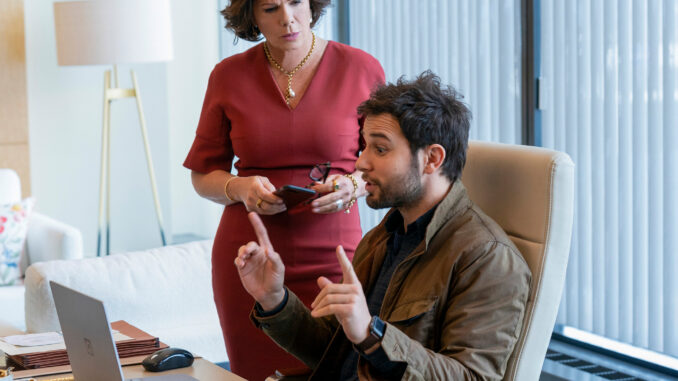
Inside the Real Relationships of the So Help Me Todd Stars: What You Didn’t See on Screen
The television screen, with its crisp visuals and carefully curated narratives, is a masterful illusionist. It presents us with worlds vibrant and characters compelling, their relationships woven into the very fabric of the story. We laugh at their witty banter, wince at their conflicts, and celebrate their triumphs, convinced we’re witnessing the entirety of their shared existence. But beneath the studio lights, beyond the meticulously rehearsed lines and perfect camera angles, lies a parallel universe of genuine human connection – the unseen dynamics that truly bind a cast together. For the stars of So Help Me Todd, this unseen world was a rich tapestry of professional respect, personal camaraderie, and the silent language of shared experience that deepened their on-screen magic.
On screen, Margaret Wright (Marcia Gay Harden) and Todd Wright (Skylar Astin) were a delightful, exasperating, and ultimately endearing mother-son duo. Their relationship was a chaotic dance of helicopter parenting and adult rebellion, seasoned with cutting remarks and an undeniable, if often unspoken, love. The brilliance of their performances lay in the razor-sharp timing and the palpable tension that could snap into tender affection at a moment’s notice. What we didn't see was the meticulous choreography of that dance, rehearsed not just in lines, but in glances, in the subtle shifts of posture, in the shared understanding forged over countless hours.
Off-screen, the dynamic between Marcia Gay Harden and Skylar Astin transcended the scripted mother-son squabbles. It blossomed into a bond rooted in mutual admiration and a touch of genuine mentorship. Harden, a seasoned Broadway and Hollywood veteran, brought an undeniable gravitas and playful authority to the set. Astin, with his youthful energy and comedic flair, met her with an eagerness to learn and an infectious enthusiasm. One might imagine the quiet moments between takes: Harden offering a gentle suggestion on a nuanced line delivery, not as a director, but as a peer sharing wisdom. Or Astin, perhaps, sharing a new TikTok trend, bringing a burst of levity to a long day. Their on-screen chemistry wasn't just acting; it was the echo of a genuine, evolving relationship, built on respect for each other’s craft and a burgeoning friendship that transcended their generational gap. The motherly exasperation Margaret often showed Todd was perhaps softened by the real affection Marcia felt for Skylar, and Todd’s often-sarcastic retorts likely carried a warmth that stemmed from Skylar’s genuine fondness for Marcia.
But the unseen relationships extended far beyond the core duo. A television set is a crucible, melting individual talents into a cohesive unit. The supporting cast – Madeline Wise as Allison, Inga Schlingmann as Susan, and the ensemble of legal colleagues and family members – contributed to a larger familial ecosystem. While their characters might have had limited interactions or even professional rivalries on screen, behind the scenes, they formed a different kind of alliance.
Picture the cafeteria or the green room: the cacophony of a busy set gives way to shared meals and inside jokes. It’s here that the stress of a demanding schedule is diffused through collective laughter, where personal milestones are celebrated, and where the silent language of empathy flourishes during difficult times. We didn't see the impromptu dance-offs, the collective groan over a particularly early call time, or the quiet commiseration when a scene required emotional vulnerability. These are the moments that forge unbreakable bonds – the shared exhaustion, the collaborative problem-solving, the collective sigh of relief when a complicated scene wraps successfully.
The "real relationships" were also about the professional trust that blossomed. When actors trust each other implicitly, they are free to take risks, to improvise subtly, to push the boundaries of their characters knowing their scene partners will catch them. This unspoken agreement, the invisible scaffolding that supports every great performance, is what truly elevates a show from good to great. It's the moment when an actor misses a line, and a colleague seamlessly covers for them without breaking character; it's the shared glance that conveys volumes without a single word being uttered. This is the unseen artistry of ensemble acting, born from hours of shared creative endeavor.
The magic of So Help Me Todd lay not just in its clever writing and engaging plots, but in the authentic human connections that blossomed off-screen and subtly infused the performances on-screen. The witty banter, the familial bickering, the moments of profound empathy – all were amplified by the genuine affection, respect, and camaraderie that existed between the actors. What we didn’t see was the daily grind, the quiet support, the laughter that bled into the serious moments, and the profound personal growth experienced together. These were the true relationships, etched not in scripts, but in shared memories and lasting friendships, proving that sometimes, the most compelling stories are the ones that never make it to the screen.
